Income Inequality in Australia: An Economic Analysis
VerifiedAdded on 2022/08/28
|19
|5005
|17
Essay
AI Summary
This essay delves into the pressing issue of increasing income inequality in Australia, examining its complexities through the lenses of economic thinkers Adam Smith and Karl Marx. The paper explores the historical context and current state of income disparities, referencing data from the OECD. It analyzes the viewpoints of Smith and Marx on wealth distribution, poverty, and the dynamics of capitalist societies. The study emphasizes the need for government intervention, specifically discussing the role of minimum wage policies in mitigating inequality. The essay assesses the potential impact of these policies, providing a comprehensive understanding of the problems associated with growing income inequality in Australia, and suggests policy recommendations to address these challenges.
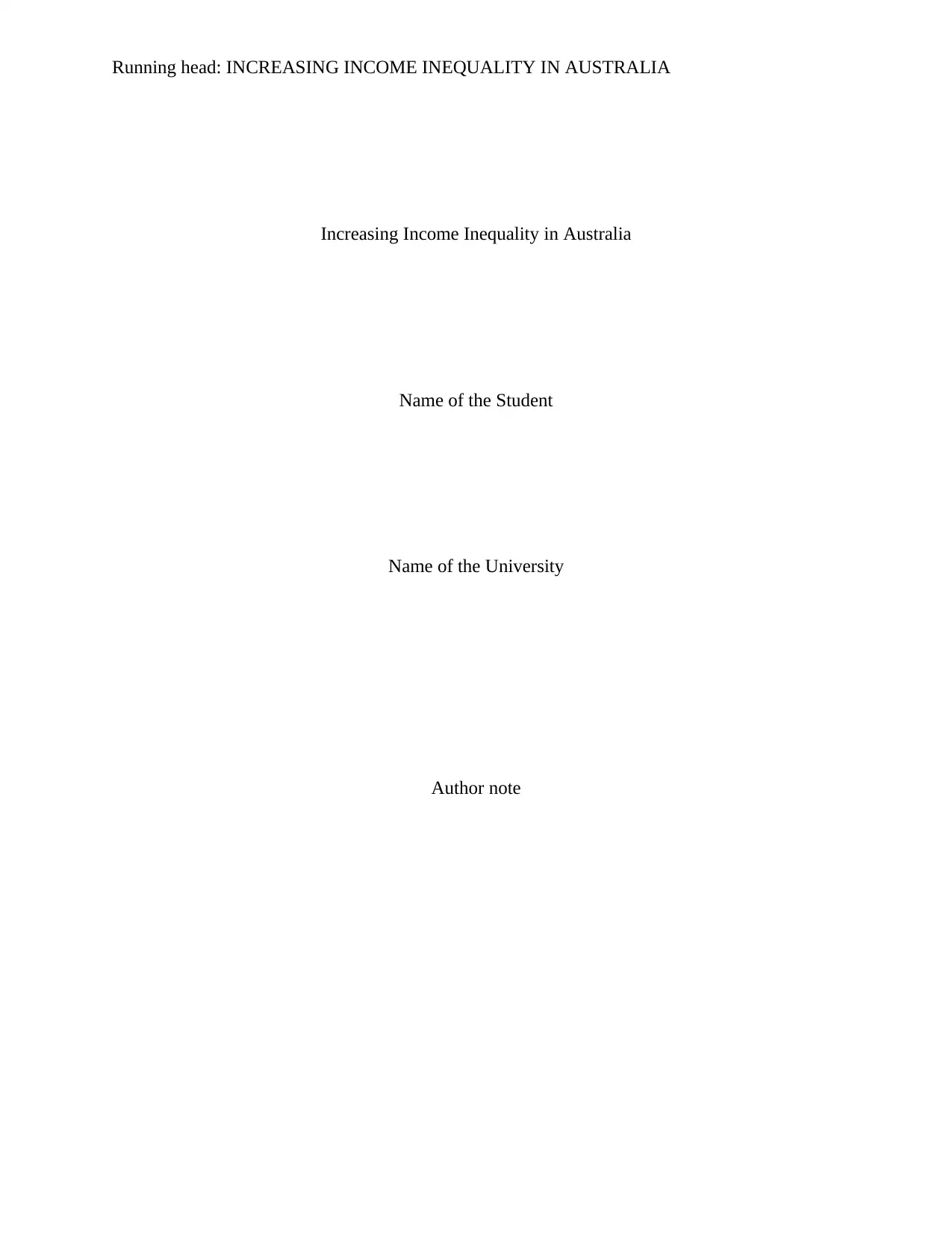
Running head: INCREASING INCOME INEQUALITY IN AUSTRALIA
Increasing Income Inequality in Australia
Name of the Student
Name of the University
Author note
Increasing Income Inequality in Australia
Name of the Student
Name of the University
Author note
Paraphrase This Document
Need a fresh take? Get an instant paraphrase of this document with our AI Paraphraser
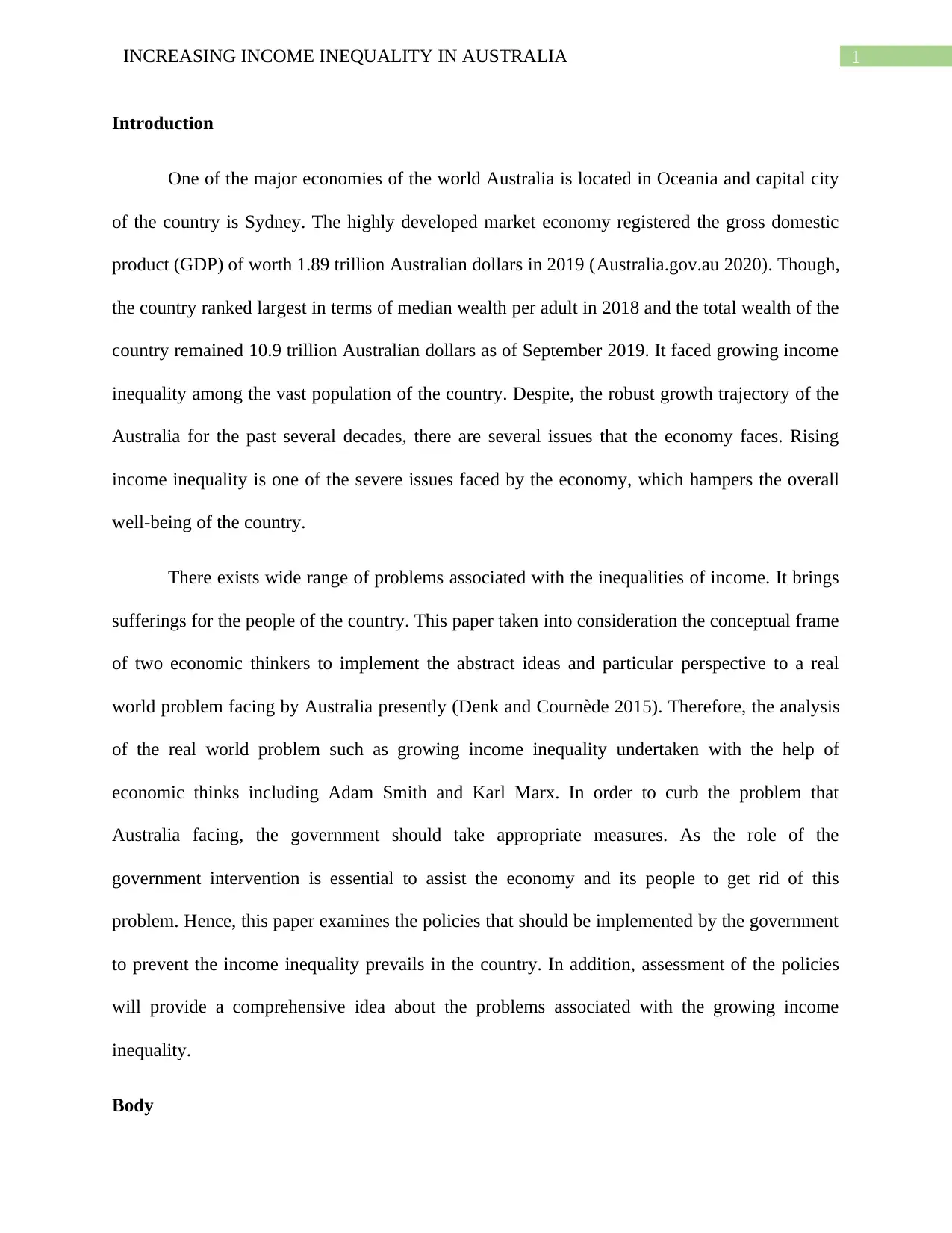
1INCREASING INCOME INEQUALITY IN AUSTRALIA
Introduction
One of the major economies of the world Australia is located in Oceania and capital city
of the country is Sydney. The highly developed market economy registered the gross domestic
product (GDP) of worth 1.89 trillion Australian dollars in 2019 (Australia.gov.au 2020). Though,
the country ranked largest in terms of median wealth per adult in 2018 and the total wealth of the
country remained 10.9 trillion Australian dollars as of September 2019. It faced growing income
inequality among the vast population of the country. Despite, the robust growth trajectory of the
Australia for the past several decades, there are several issues that the economy faces. Rising
income inequality is one of the severe issues faced by the economy, which hampers the overall
well-being of the country.
There exists wide range of problems associated with the inequalities of income. It brings
sufferings for the people of the country. This paper taken into consideration the conceptual frame
of two economic thinkers to implement the abstract ideas and particular perspective to a real
world problem facing by Australia presently (Denk and Cournède 2015). Therefore, the analysis
of the real world problem such as growing income inequality undertaken with the help of
economic thinks including Adam Smith and Karl Marx. In order to curb the problem that
Australia facing, the government should take appropriate measures. As the role of the
government intervention is essential to assist the economy and its people to get rid of this
problem. Hence, this paper examines the policies that should be implemented by the government
to prevent the income inequality prevails in the country. In addition, assessment of the policies
will provide a comprehensive idea about the problems associated with the growing income
inequality.
Body
Introduction
One of the major economies of the world Australia is located in Oceania and capital city
of the country is Sydney. The highly developed market economy registered the gross domestic
product (GDP) of worth 1.89 trillion Australian dollars in 2019 (Australia.gov.au 2020). Though,
the country ranked largest in terms of median wealth per adult in 2018 and the total wealth of the
country remained 10.9 trillion Australian dollars as of September 2019. It faced growing income
inequality among the vast population of the country. Despite, the robust growth trajectory of the
Australia for the past several decades, there are several issues that the economy faces. Rising
income inequality is one of the severe issues faced by the economy, which hampers the overall
well-being of the country.
There exists wide range of problems associated with the inequalities of income. It brings
sufferings for the people of the country. This paper taken into consideration the conceptual frame
of two economic thinkers to implement the abstract ideas and particular perspective to a real
world problem facing by Australia presently (Denk and Cournède 2015). Therefore, the analysis
of the real world problem such as growing income inequality undertaken with the help of
economic thinks including Adam Smith and Karl Marx. In order to curb the problem that
Australia facing, the government should take appropriate measures. As the role of the
government intervention is essential to assist the economy and its people to get rid of this
problem. Hence, this paper examines the policies that should be implemented by the government
to prevent the income inequality prevails in the country. In addition, assessment of the policies
will provide a comprehensive idea about the problems associated with the growing income
inequality.
Body
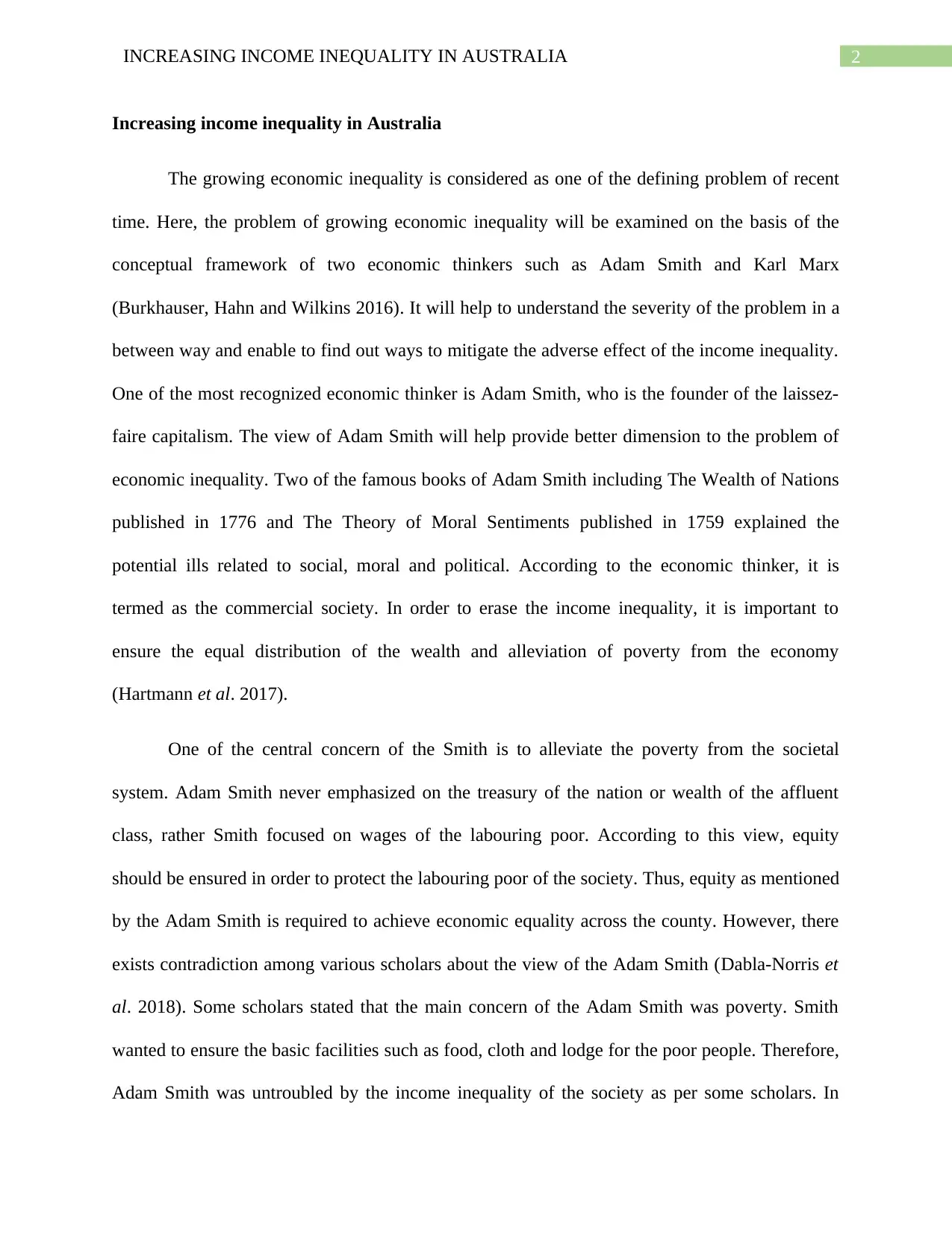
2INCREASING INCOME INEQUALITY IN AUSTRALIA
Increasing income inequality in Australia
The growing economic inequality is considered as one of the defining problem of recent
time. Here, the problem of growing economic inequality will be examined on the basis of the
conceptual framework of two economic thinkers such as Adam Smith and Karl Marx
(Burkhauser, Hahn and Wilkins 2016). It will help to understand the severity of the problem in a
between way and enable to find out ways to mitigate the adverse effect of the income inequality.
One of the most recognized economic thinker is Adam Smith, who is the founder of the laissez-
faire capitalism. The view of Adam Smith will help provide better dimension to the problem of
economic inequality. Two of the famous books of Adam Smith including The Wealth of Nations
published in 1776 and The Theory of Moral Sentiments published in 1759 explained the
potential ills related to social, moral and political. According to the economic thinker, it is
termed as the commercial society. In order to erase the income inequality, it is important to
ensure the equal distribution of the wealth and alleviation of poverty from the economy
(Hartmann et al. 2017).
One of the central concern of the Smith is to alleviate the poverty from the societal
system. Adam Smith never emphasized on the treasury of the nation or wealth of the affluent
class, rather Smith focused on wages of the labouring poor. According to this view, equity
should be ensured in order to protect the labouring poor of the society. Thus, equity as mentioned
by the Adam Smith is required to achieve economic equality across the county. However, there
exists contradiction among various scholars about the view of the Adam Smith (Dabla-Norris et
al. 2018). Some scholars stated that the main concern of the Adam Smith was poverty. Smith
wanted to ensure the basic facilities such as food, cloth and lodge for the poor people. Therefore,
Adam Smith was untroubled by the income inequality of the society as per some scholars. In
Increasing income inequality in Australia
The growing economic inequality is considered as one of the defining problem of recent
time. Here, the problem of growing economic inequality will be examined on the basis of the
conceptual framework of two economic thinkers such as Adam Smith and Karl Marx
(Burkhauser, Hahn and Wilkins 2016). It will help to understand the severity of the problem in a
between way and enable to find out ways to mitigate the adverse effect of the income inequality.
One of the most recognized economic thinker is Adam Smith, who is the founder of the laissez-
faire capitalism. The view of Adam Smith will help provide better dimension to the problem of
economic inequality. Two of the famous books of Adam Smith including The Wealth of Nations
published in 1776 and The Theory of Moral Sentiments published in 1759 explained the
potential ills related to social, moral and political. According to the economic thinker, it is
termed as the commercial society. In order to erase the income inequality, it is important to
ensure the equal distribution of the wealth and alleviation of poverty from the economy
(Hartmann et al. 2017).
One of the central concern of the Smith is to alleviate the poverty from the societal
system. Adam Smith never emphasized on the treasury of the nation or wealth of the affluent
class, rather Smith focused on wages of the labouring poor. According to this view, equity
should be ensured in order to protect the labouring poor of the society. Thus, equity as mentioned
by the Adam Smith is required to achieve economic equality across the county. However, there
exists contradiction among various scholars about the view of the Adam Smith (Dabla-Norris et
al. 2018). Some scholars stated that the main concern of the Adam Smith was poverty. Smith
wanted to ensure the basic facilities such as food, cloth and lodge for the poor people. Therefore,
Adam Smith was untroubled by the income inequality of the society as per some scholars. In
⊘ This is a preview!⊘
Do you want full access?
Subscribe today to unlock all pages.

Trusted by 1+ million students worldwide
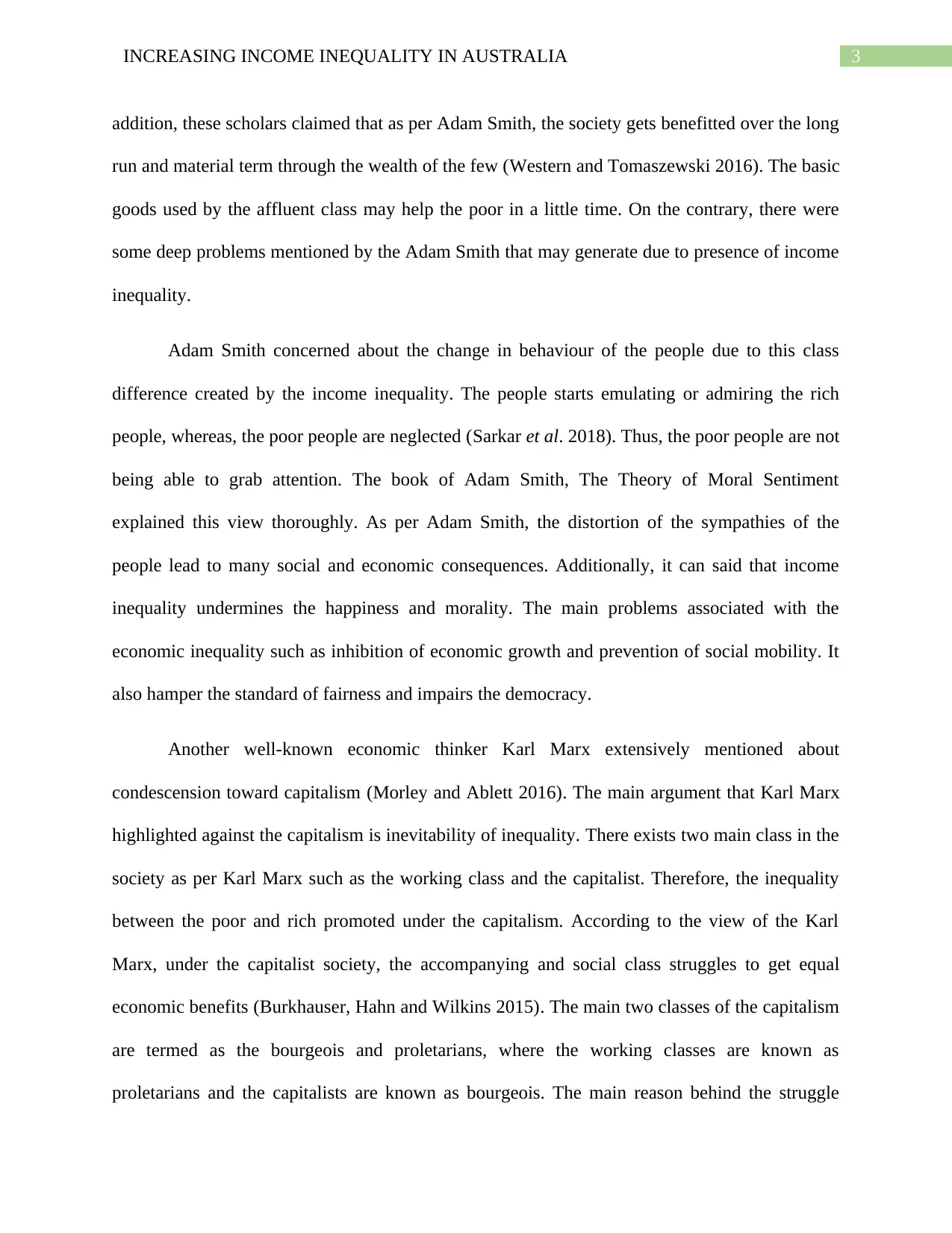
3INCREASING INCOME INEQUALITY IN AUSTRALIA
addition, these scholars claimed that as per Adam Smith, the society gets benefitted over the long
run and material term through the wealth of the few (Western and Tomaszewski 2016). The basic
goods used by the affluent class may help the poor in a little time. On the contrary, there were
some deep problems mentioned by the Adam Smith that may generate due to presence of income
inequality.
Adam Smith concerned about the change in behaviour of the people due to this class
difference created by the income inequality. The people starts emulating or admiring the rich
people, whereas, the poor people are neglected (Sarkar et al. 2018). Thus, the poor people are not
being able to grab attention. The book of Adam Smith, The Theory of Moral Sentiment
explained this view thoroughly. As per Adam Smith, the distortion of the sympathies of the
people lead to many social and economic consequences. Additionally, it can said that income
inequality undermines the happiness and morality. The main problems associated with the
economic inequality such as inhibition of economic growth and prevention of social mobility. It
also hamper the standard of fairness and impairs the democracy.
Another well-known economic thinker Karl Marx extensively mentioned about
condescension toward capitalism (Morley and Ablett 2016). The main argument that Karl Marx
highlighted against the capitalism is inevitability of inequality. There exists two main class in the
society as per Karl Marx such as the working class and the capitalist. Therefore, the inequality
between the poor and rich promoted under the capitalism. According to the view of the Karl
Marx, under the capitalist society, the accompanying and social class struggles to get equal
economic benefits (Burkhauser, Hahn and Wilkins 2015). The main two classes of the capitalism
are termed as the bourgeois and proletarians, where the working classes are known as
proletarians and the capitalists are known as bourgeois. The main reason behind the struggle
addition, these scholars claimed that as per Adam Smith, the society gets benefitted over the long
run and material term through the wealth of the few (Western and Tomaszewski 2016). The basic
goods used by the affluent class may help the poor in a little time. On the contrary, there were
some deep problems mentioned by the Adam Smith that may generate due to presence of income
inequality.
Adam Smith concerned about the change in behaviour of the people due to this class
difference created by the income inequality. The people starts emulating or admiring the rich
people, whereas, the poor people are neglected (Sarkar et al. 2018). Thus, the poor people are not
being able to grab attention. The book of Adam Smith, The Theory of Moral Sentiment
explained this view thoroughly. As per Adam Smith, the distortion of the sympathies of the
people lead to many social and economic consequences. Additionally, it can said that income
inequality undermines the happiness and morality. The main problems associated with the
economic inequality such as inhibition of economic growth and prevention of social mobility. It
also hamper the standard of fairness and impairs the democracy.
Another well-known economic thinker Karl Marx extensively mentioned about
condescension toward capitalism (Morley and Ablett 2016). The main argument that Karl Marx
highlighted against the capitalism is inevitability of inequality. There exists two main class in the
society as per Karl Marx such as the working class and the capitalist. Therefore, the inequality
between the poor and rich promoted under the capitalism. According to the view of the Karl
Marx, under the capitalist society, the accompanying and social class struggles to get equal
economic benefits (Burkhauser, Hahn and Wilkins 2015). The main two classes of the capitalism
are termed as the bourgeois and proletarians, where the working classes are known as
proletarians and the capitalists are known as bourgeois. The main reason behind the struggle
Paraphrase This Document
Need a fresh take? Get an instant paraphrase of this document with our AI Paraphraser
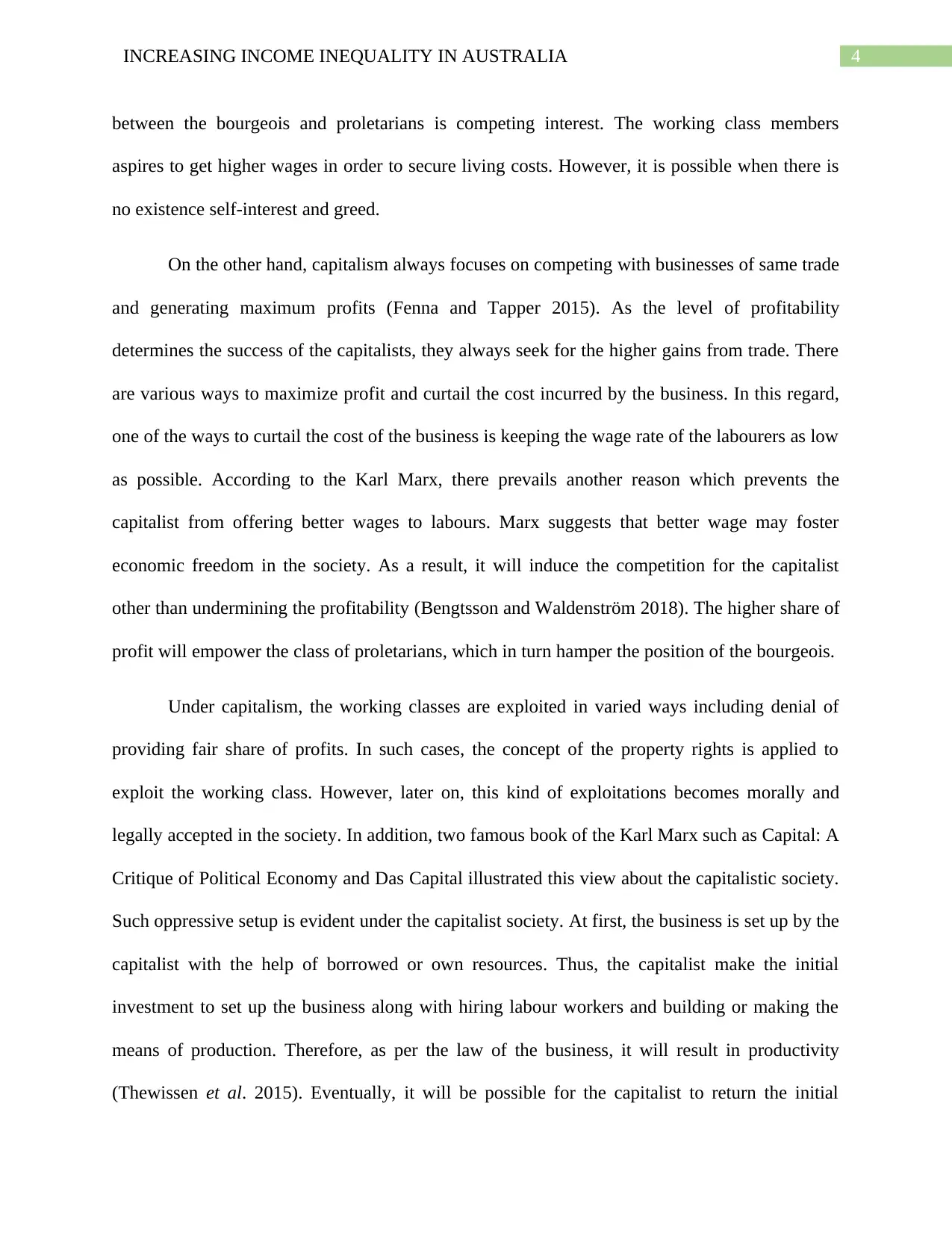
4INCREASING INCOME INEQUALITY IN AUSTRALIA
between the bourgeois and proletarians is competing interest. The working class members
aspires to get higher wages in order to secure living costs. However, it is possible when there is
no existence self-interest and greed.
On the other hand, capitalism always focuses on competing with businesses of same trade
and generating maximum profits (Fenna and Tapper 2015). As the level of profitability
determines the success of the capitalists, they always seek for the higher gains from trade. There
are various ways to maximize profit and curtail the cost incurred by the business. In this regard,
one of the ways to curtail the cost of the business is keeping the wage rate of the labourers as low
as possible. According to the Karl Marx, there prevails another reason which prevents the
capitalist from offering better wages to labours. Marx suggests that better wage may foster
economic freedom in the society. As a result, it will induce the competition for the capitalist
other than undermining the profitability (Bengtsson and Waldenström 2018). The higher share of
profit will empower the class of proletarians, which in turn hamper the position of the bourgeois.
Under capitalism, the working classes are exploited in varied ways including denial of
providing fair share of profits. In such cases, the concept of the property rights is applied to
exploit the working class. However, later on, this kind of exploitations becomes morally and
legally accepted in the society. In addition, two famous book of the Karl Marx such as Capital: A
Critique of Political Economy and Das Capital illustrated this view about the capitalistic society.
Such oppressive setup is evident under the capitalist society. At first, the business is set up by the
capitalist with the help of borrowed or own resources. Thus, the capitalist make the initial
investment to set up the business along with hiring labour workers and building or making the
means of production. Therefore, as per the law of the business, it will result in productivity
(Thewissen et al. 2015). Eventually, it will be possible for the capitalist to return the initial
between the bourgeois and proletarians is competing interest. The working class members
aspires to get higher wages in order to secure living costs. However, it is possible when there is
no existence self-interest and greed.
On the other hand, capitalism always focuses on competing with businesses of same trade
and generating maximum profits (Fenna and Tapper 2015). As the level of profitability
determines the success of the capitalists, they always seek for the higher gains from trade. There
are various ways to maximize profit and curtail the cost incurred by the business. In this regard,
one of the ways to curtail the cost of the business is keeping the wage rate of the labourers as low
as possible. According to the Karl Marx, there prevails another reason which prevents the
capitalist from offering better wages to labours. Marx suggests that better wage may foster
economic freedom in the society. As a result, it will induce the competition for the capitalist
other than undermining the profitability (Bengtsson and Waldenström 2018). The higher share of
profit will empower the class of proletarians, which in turn hamper the position of the bourgeois.
Under capitalism, the working classes are exploited in varied ways including denial of
providing fair share of profits. In such cases, the concept of the property rights is applied to
exploit the working class. However, later on, this kind of exploitations becomes morally and
legally accepted in the society. In addition, two famous book of the Karl Marx such as Capital: A
Critique of Political Economy and Das Capital illustrated this view about the capitalistic society.
Such oppressive setup is evident under the capitalist society. At first, the business is set up by the
capitalist with the help of borrowed or own resources. Thus, the capitalist make the initial
investment to set up the business along with hiring labour workers and building or making the
means of production. Therefore, as per the law of the business, it will result in productivity
(Thewissen et al. 2015). Eventually, it will be possible for the capitalist to return the initial
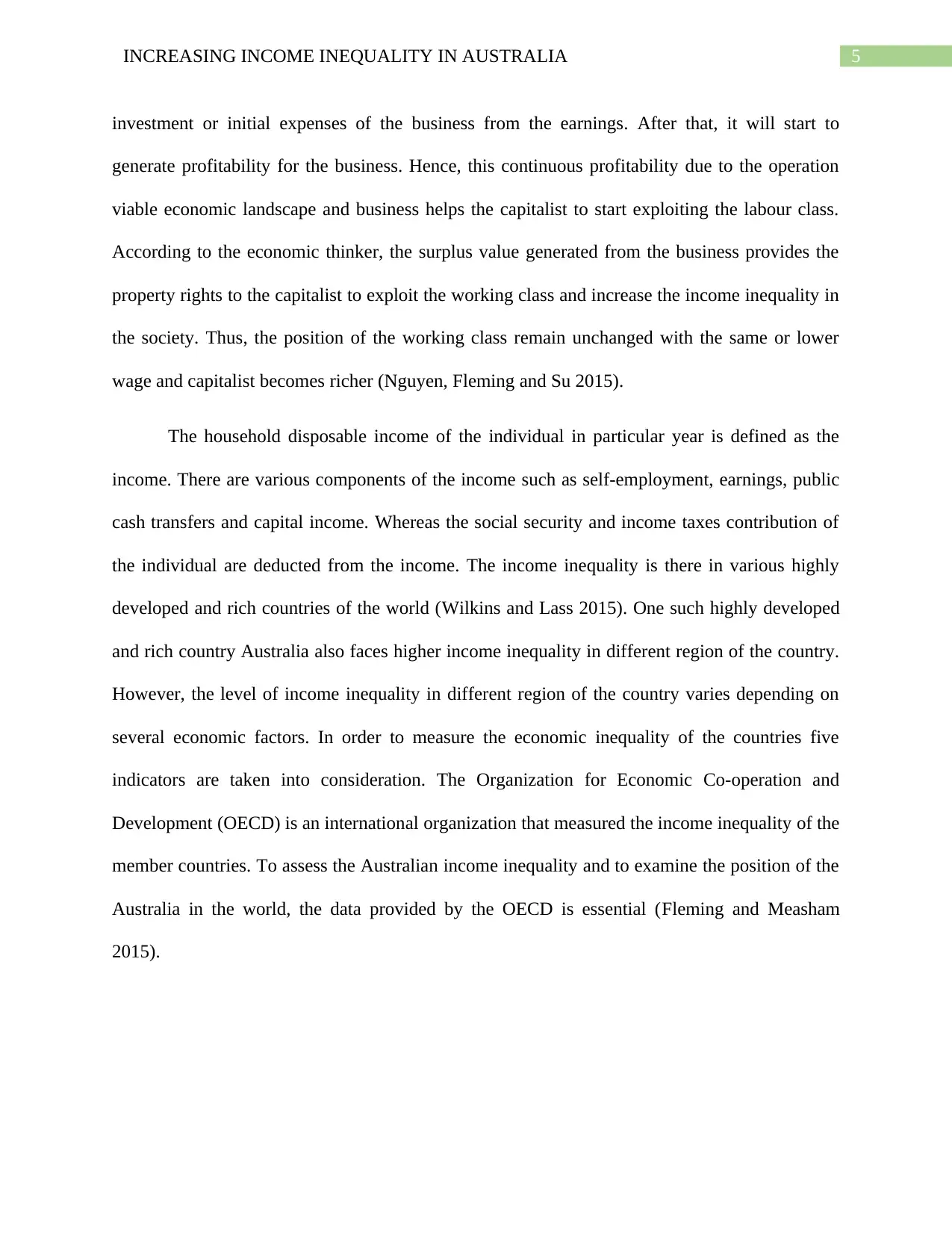
5INCREASING INCOME INEQUALITY IN AUSTRALIA
investment or initial expenses of the business from the earnings. After that, it will start to
generate profitability for the business. Hence, this continuous profitability due to the operation
viable economic landscape and business helps the capitalist to start exploiting the labour class.
According to the economic thinker, the surplus value generated from the business provides the
property rights to the capitalist to exploit the working class and increase the income inequality in
the society. Thus, the position of the working class remain unchanged with the same or lower
wage and capitalist becomes richer (Nguyen, Fleming and Su 2015).
The household disposable income of the individual in particular year is defined as the
income. There are various components of the income such as self-employment, earnings, public
cash transfers and capital income. Whereas the social security and income taxes contribution of
the individual are deducted from the income. The income inequality is there in various highly
developed and rich countries of the world (Wilkins and Lass 2015). One such highly developed
and rich country Australia also faces higher income inequality in different region of the country.
However, the level of income inequality in different region of the country varies depending on
several economic factors. In order to measure the economic inequality of the countries five
indicators are taken into consideration. The Organization for Economic Co-operation and
Development (OECD) is an international organization that measured the income inequality of the
member countries. To assess the Australian income inequality and to examine the position of the
Australia in the world, the data provided by the OECD is essential (Fleming and Measham
2015).
investment or initial expenses of the business from the earnings. After that, it will start to
generate profitability for the business. Hence, this continuous profitability due to the operation
viable economic landscape and business helps the capitalist to start exploiting the labour class.
According to the economic thinker, the surplus value generated from the business provides the
property rights to the capitalist to exploit the working class and increase the income inequality in
the society. Thus, the position of the working class remain unchanged with the same or lower
wage and capitalist becomes richer (Nguyen, Fleming and Su 2015).
The household disposable income of the individual in particular year is defined as the
income. There are various components of the income such as self-employment, earnings, public
cash transfers and capital income. Whereas the social security and income taxes contribution of
the individual are deducted from the income. The income inequality is there in various highly
developed and rich countries of the world (Wilkins and Lass 2015). One such highly developed
and rich country Australia also faces higher income inequality in different region of the country.
However, the level of income inequality in different region of the country varies depending on
several economic factors. In order to measure the economic inequality of the countries five
indicators are taken into consideration. The Organization for Economic Co-operation and
Development (OECD) is an international organization that measured the income inequality of the
member countries. To assess the Australian income inequality and to examine the position of the
Australia in the world, the data provided by the OECD is essential (Fleming and Measham
2015).
⊘ This is a preview!⊘
Do you want full access?
Subscribe today to unlock all pages.

Trusted by 1+ million students worldwide
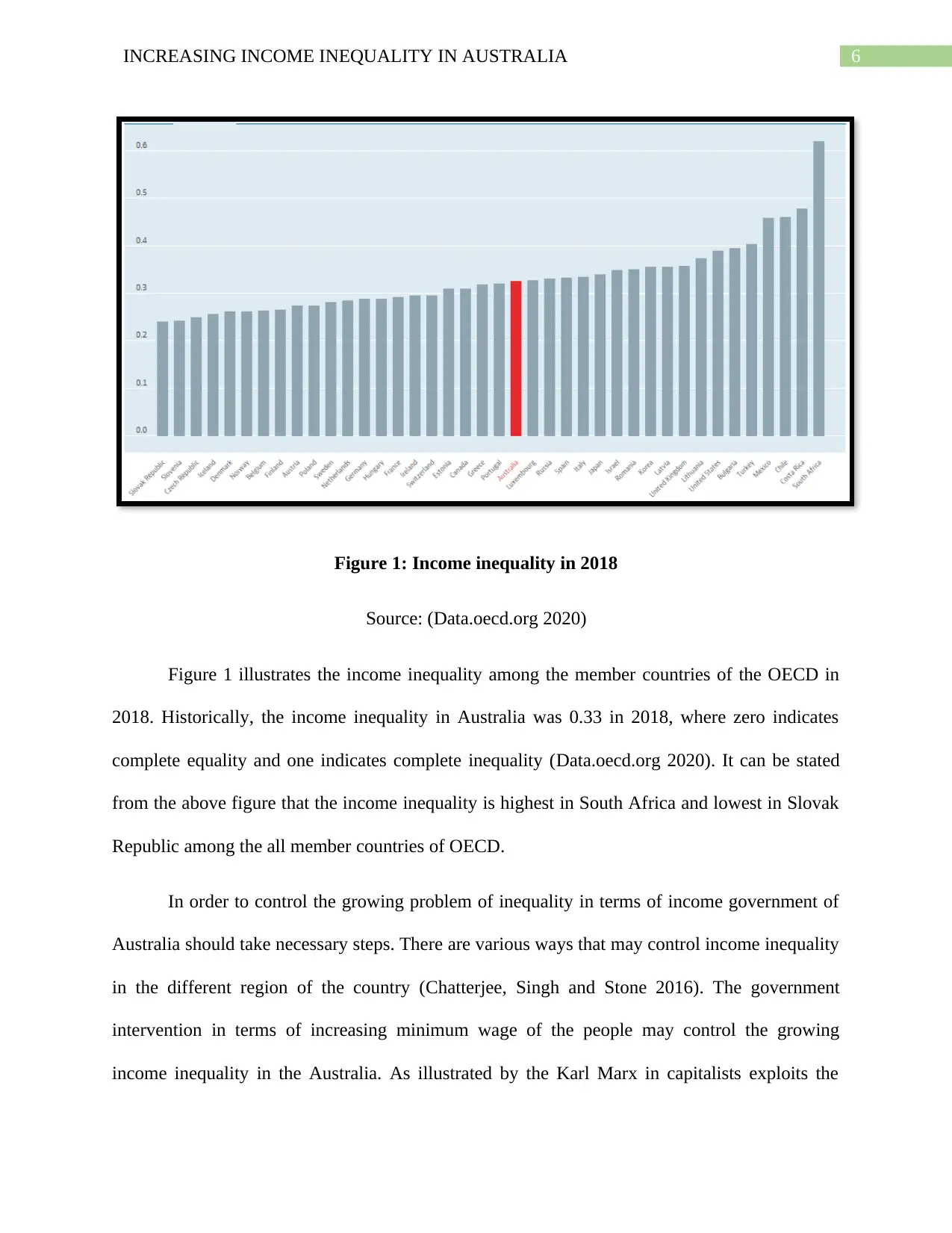
6INCREASING INCOME INEQUALITY IN AUSTRALIA
Figure 1: Income inequality in 2018
Source: (Data.oecd.org 2020)
Figure 1 illustrates the income inequality among the member countries of the OECD in
2018. Historically, the income inequality in Australia was 0.33 in 2018, where zero indicates
complete equality and one indicates complete inequality (Data.oecd.org 2020). It can be stated
from the above figure that the income inequality is highest in South Africa and lowest in Slovak
Republic among the all member countries of OECD.
In order to control the growing problem of inequality in terms of income government of
Australia should take necessary steps. There are various ways that may control income inequality
in the different region of the country (Chatterjee, Singh and Stone 2016). The government
intervention in terms of increasing minimum wage of the people may control the growing
income inequality in the Australia. As illustrated by the Karl Marx in capitalists exploits the
Figure 1: Income inequality in 2018
Source: (Data.oecd.org 2020)
Figure 1 illustrates the income inequality among the member countries of the OECD in
2018. Historically, the income inequality in Australia was 0.33 in 2018, where zero indicates
complete equality and one indicates complete inequality (Data.oecd.org 2020). It can be stated
from the above figure that the income inequality is highest in South Africa and lowest in Slovak
Republic among the all member countries of OECD.
In order to control the growing problem of inequality in terms of income government of
Australia should take necessary steps. There are various ways that may control income inequality
in the different region of the country (Chatterjee, Singh and Stone 2016). The government
intervention in terms of increasing minimum wage of the people may control the growing
income inequality in the Australia. As illustrated by the Karl Marx in capitalists exploits the
Paraphrase This Document
Need a fresh take? Get an instant paraphrase of this document with our AI Paraphraser
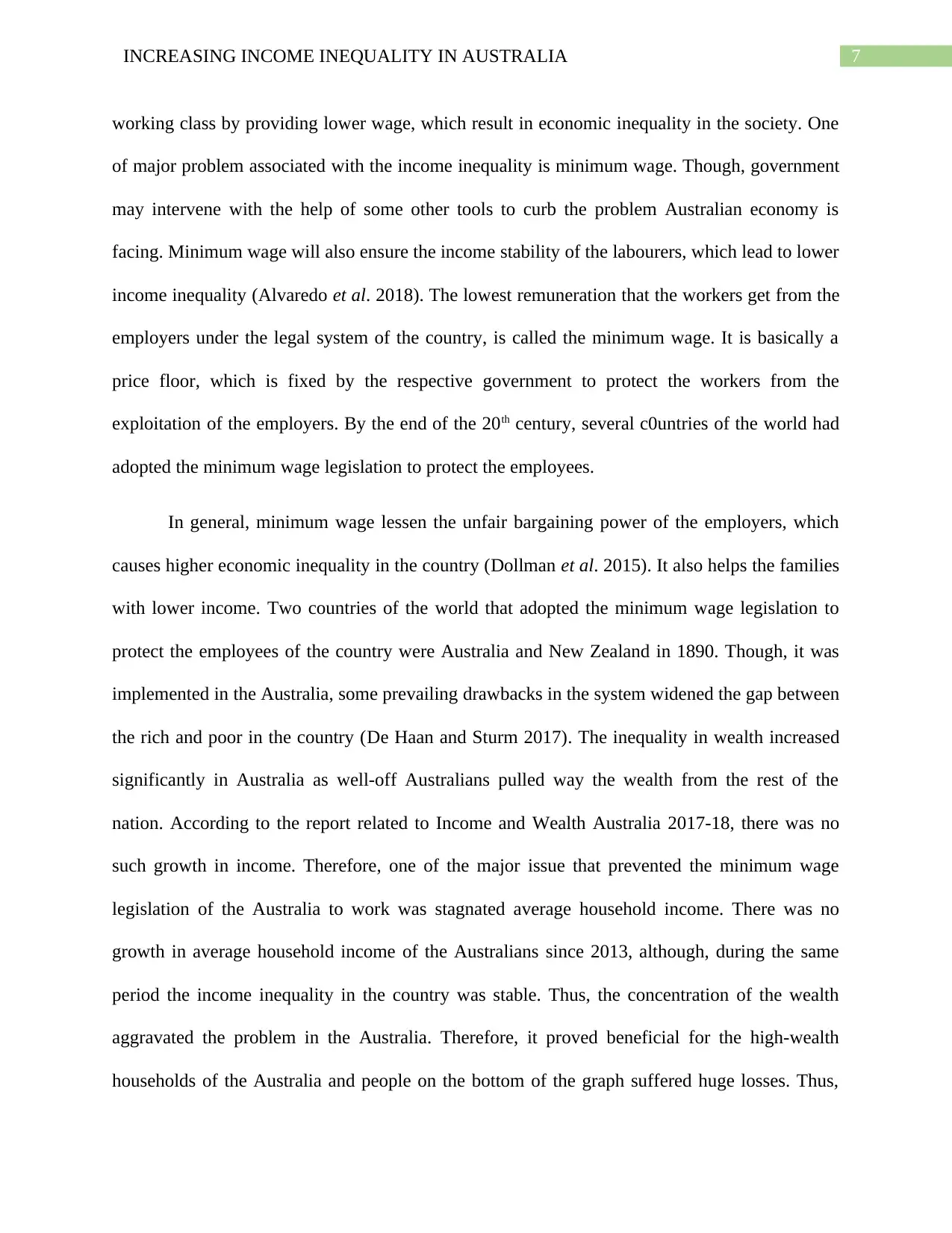
7INCREASING INCOME INEQUALITY IN AUSTRALIA
working class by providing lower wage, which result in economic inequality in the society. One
of major problem associated with the income inequality is minimum wage. Though, government
may intervene with the help of some other tools to curb the problem Australian economy is
facing. Minimum wage will also ensure the income stability of the labourers, which lead to lower
income inequality (Alvaredo et al. 2018). The lowest remuneration that the workers get from the
employers under the legal system of the country, is called the minimum wage. It is basically a
price floor, which is fixed by the respective government to protect the workers from the
exploitation of the employers. By the end of the 20th century, several c0untries of the world had
adopted the minimum wage legislation to protect the employees.
In general, minimum wage lessen the unfair bargaining power of the employers, which
causes higher economic inequality in the country (Dollman et al. 2015). It also helps the families
with lower income. Two countries of the world that adopted the minimum wage legislation to
protect the employees of the country were Australia and New Zealand in 1890. Though, it was
implemented in the Australia, some prevailing drawbacks in the system widened the gap between
the rich and poor in the country (De Haan and Sturm 2017). The inequality in wealth increased
significantly in Australia as well-off Australians pulled way the wealth from the rest of the
nation. According to the report related to Income and Wealth Australia 2017-18, there was no
such growth in income. Therefore, one of the major issue that prevented the minimum wage
legislation of the Australia to work was stagnated average household income. There was no
growth in average household income of the Australians since 2013, although, during the same
period the income inequality in the country was stable. Thus, the concentration of the wealth
aggravated the problem in the Australia. Therefore, it proved beneficial for the high-wealth
households of the Australia and people on the bottom of the graph suffered huge losses. Thus,
working class by providing lower wage, which result in economic inequality in the society. One
of major problem associated with the income inequality is minimum wage. Though, government
may intervene with the help of some other tools to curb the problem Australian economy is
facing. Minimum wage will also ensure the income stability of the labourers, which lead to lower
income inequality (Alvaredo et al. 2018). The lowest remuneration that the workers get from the
employers under the legal system of the country, is called the minimum wage. It is basically a
price floor, which is fixed by the respective government to protect the workers from the
exploitation of the employers. By the end of the 20th century, several c0untries of the world had
adopted the minimum wage legislation to protect the employees.
In general, minimum wage lessen the unfair bargaining power of the employers, which
causes higher economic inequality in the country (Dollman et al. 2015). It also helps the families
with lower income. Two countries of the world that adopted the minimum wage legislation to
protect the employees of the country were Australia and New Zealand in 1890. Though, it was
implemented in the Australia, some prevailing drawbacks in the system widened the gap between
the rich and poor in the country (De Haan and Sturm 2017). The inequality in wealth increased
significantly in Australia as well-off Australians pulled way the wealth from the rest of the
nation. According to the report related to Income and Wealth Australia 2017-18, there was no
such growth in income. Therefore, one of the major issue that prevented the minimum wage
legislation of the Australia to work was stagnated average household income. There was no
growth in average household income of the Australians since 2013, although, during the same
period the income inequality in the country was stable. Thus, the concentration of the wealth
aggravated the problem in the Australia. Therefore, it proved beneficial for the high-wealth
households of the Australia and people on the bottom of the graph suffered huge losses. Thus,
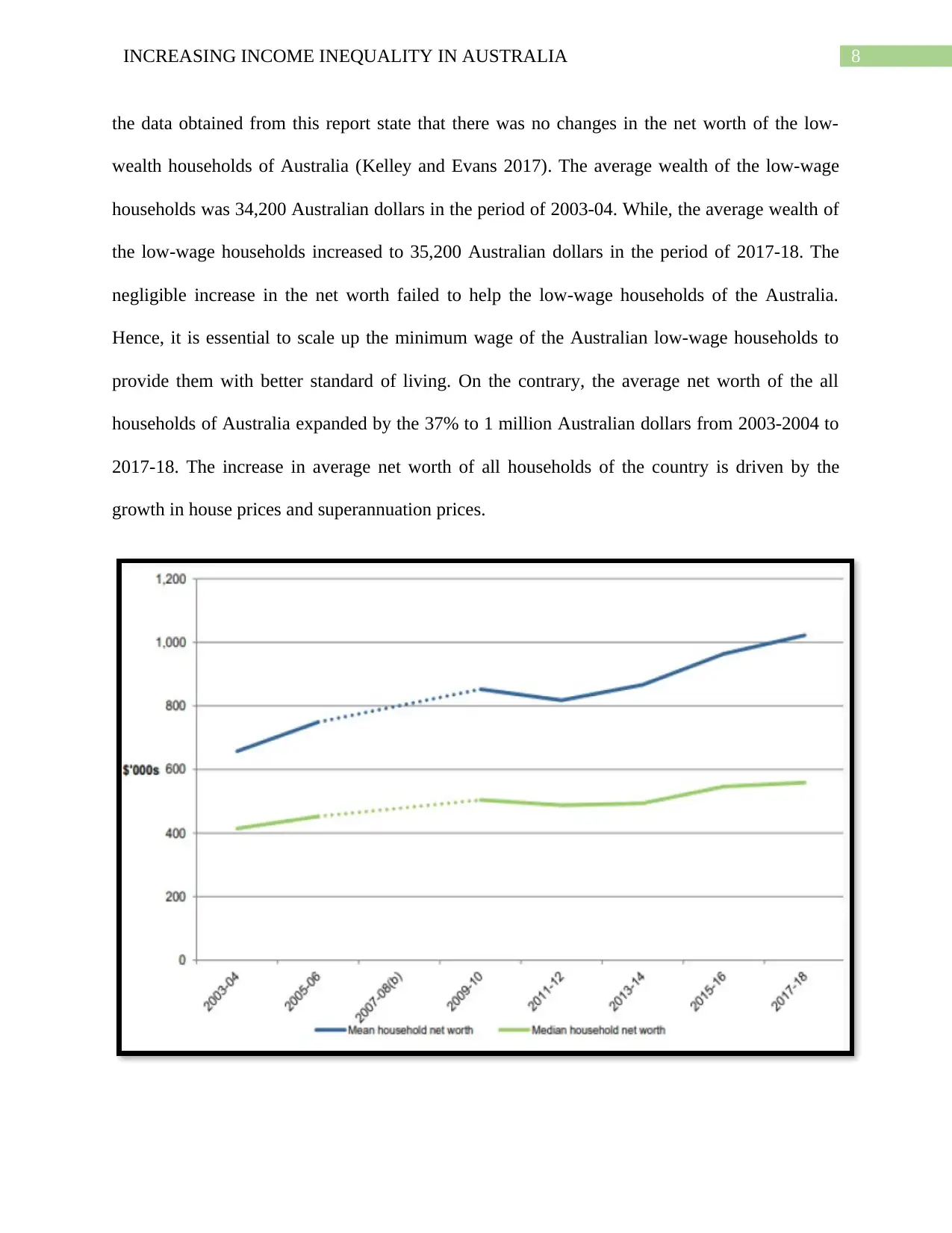
8INCREASING INCOME INEQUALITY IN AUSTRALIA
the data obtained from this report state that there was no changes in the net worth of the low-
wealth households of Australia (Kelley and Evans 2017). The average wealth of the low-wage
households was 34,200 Australian dollars in the period of 2003-04. While, the average wealth of
the low-wage households increased to 35,200 Australian dollars in the period of 2017-18. The
negligible increase in the net worth failed to help the low-wage households of the Australia.
Hence, it is essential to scale up the minimum wage of the Australian low-wage households to
provide them with better standard of living. On the contrary, the average net worth of the all
households of Australia expanded by the 37% to 1 million Australian dollars from 2003-2004 to
2017-18. The increase in average net worth of all households of the country is driven by the
growth in house prices and superannuation prices.
the data obtained from this report state that there was no changes in the net worth of the low-
wealth households of Australia (Kelley and Evans 2017). The average wealth of the low-wage
households was 34,200 Australian dollars in the period of 2003-04. While, the average wealth of
the low-wage households increased to 35,200 Australian dollars in the period of 2017-18. The
negligible increase in the net worth failed to help the low-wage households of the Australia.
Hence, it is essential to scale up the minimum wage of the Australian low-wage households to
provide them with better standard of living. On the contrary, the average net worth of the all
households of Australia expanded by the 37% to 1 million Australian dollars from 2003-2004 to
2017-18. The increase in average net worth of all households of the country is driven by the
growth in house prices and superannuation prices.
⊘ This is a preview!⊘
Do you want full access?
Subscribe today to unlock all pages.

Trusted by 1+ million students worldwide
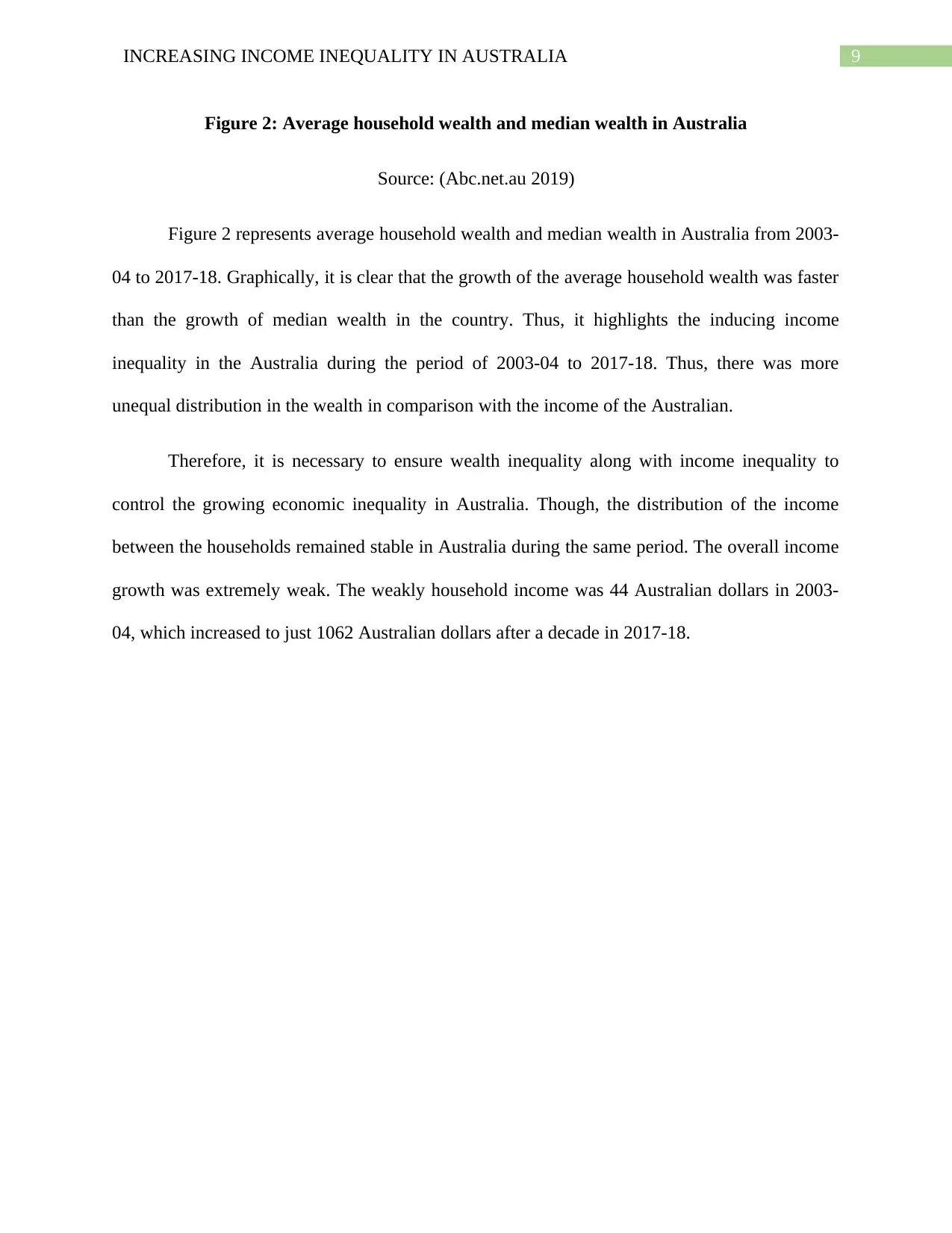
9INCREASING INCOME INEQUALITY IN AUSTRALIA
Figure 2: Average household wealth and median wealth in Australia
Source: (Abc.net.au 2019)
Figure 2 represents average household wealth and median wealth in Australia from 2003-
04 to 2017-18. Graphically, it is clear that the growth of the average household wealth was faster
than the growth of median wealth in the country. Thus, it highlights the inducing income
inequality in the Australia during the period of 2003-04 to 2017-18. Thus, there was more
unequal distribution in the wealth in comparison with the income of the Australian.
Therefore, it is necessary to ensure wealth inequality along with income inequality to
control the growing economic inequality in Australia. Though, the distribution of the income
between the households remained stable in Australia during the same period. The overall income
growth was extremely weak. The weakly household income was 44 Australian dollars in 2003-
04, which increased to just 1062 Australian dollars after a decade in 2017-18.
Figure 2: Average household wealth and median wealth in Australia
Source: (Abc.net.au 2019)
Figure 2 represents average household wealth and median wealth in Australia from 2003-
04 to 2017-18. Graphically, it is clear that the growth of the average household wealth was faster
than the growth of median wealth in the country. Thus, it highlights the inducing income
inequality in the Australia during the period of 2003-04 to 2017-18. Thus, there was more
unequal distribution in the wealth in comparison with the income of the Australian.
Therefore, it is necessary to ensure wealth inequality along with income inequality to
control the growing economic inequality in Australia. Though, the distribution of the income
between the households remained stable in Australia during the same period. The overall income
growth was extremely weak. The weakly household income was 44 Australian dollars in 2003-
04, which increased to just 1062 Australian dollars after a decade in 2017-18.
Paraphrase This Document
Need a fresh take? Get an instant paraphrase of this document with our AI Paraphraser
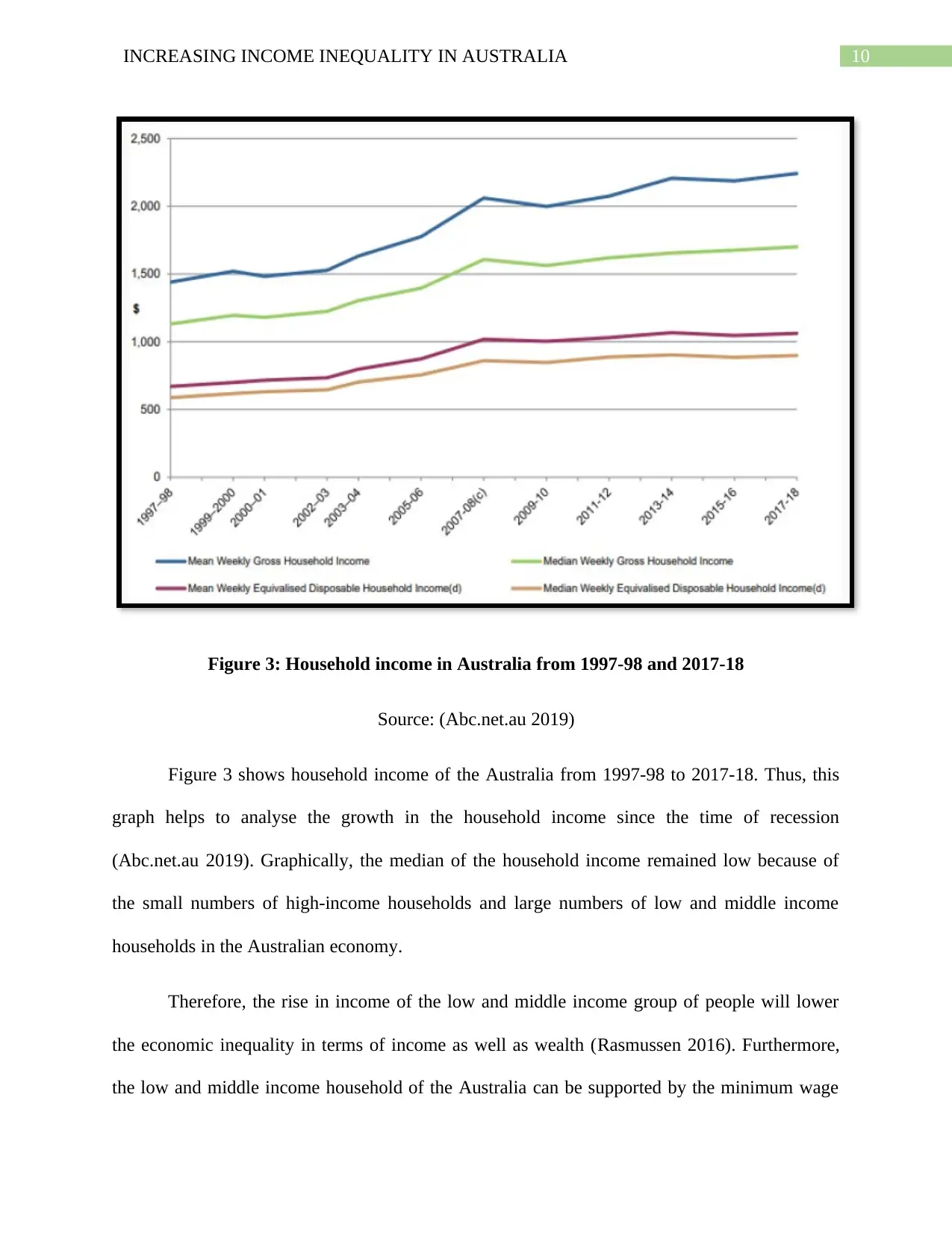
10INCREASING INCOME INEQUALITY IN AUSTRALIA
Figure 3: Household income in Australia from 1997-98 and 2017-18
Source: (Abc.net.au 2019)
Figure 3 shows household income of the Australia from 1997-98 to 2017-18. Thus, this
graph helps to analyse the growth in the household income since the time of recession
(Abc.net.au 2019). Graphically, the median of the household income remained low because of
the small numbers of high-income households and large numbers of low and middle income
households in the Australian economy.
Therefore, the rise in income of the low and middle income group of people will lower
the economic inequality in terms of income as well as wealth (Rasmussen 2016). Furthermore,
the low and middle income household of the Australia can be supported by the minimum wage
Figure 3: Household income in Australia from 1997-98 and 2017-18
Source: (Abc.net.au 2019)
Figure 3 shows household income of the Australia from 1997-98 to 2017-18. Thus, this
graph helps to analyse the growth in the household income since the time of recession
(Abc.net.au 2019). Graphically, the median of the household income remained low because of
the small numbers of high-income households and large numbers of low and middle income
households in the Australian economy.
Therefore, the rise in income of the low and middle income group of people will lower
the economic inequality in terms of income as well as wealth (Rasmussen 2016). Furthermore,
the low and middle income household of the Australia can be supported by the minimum wage
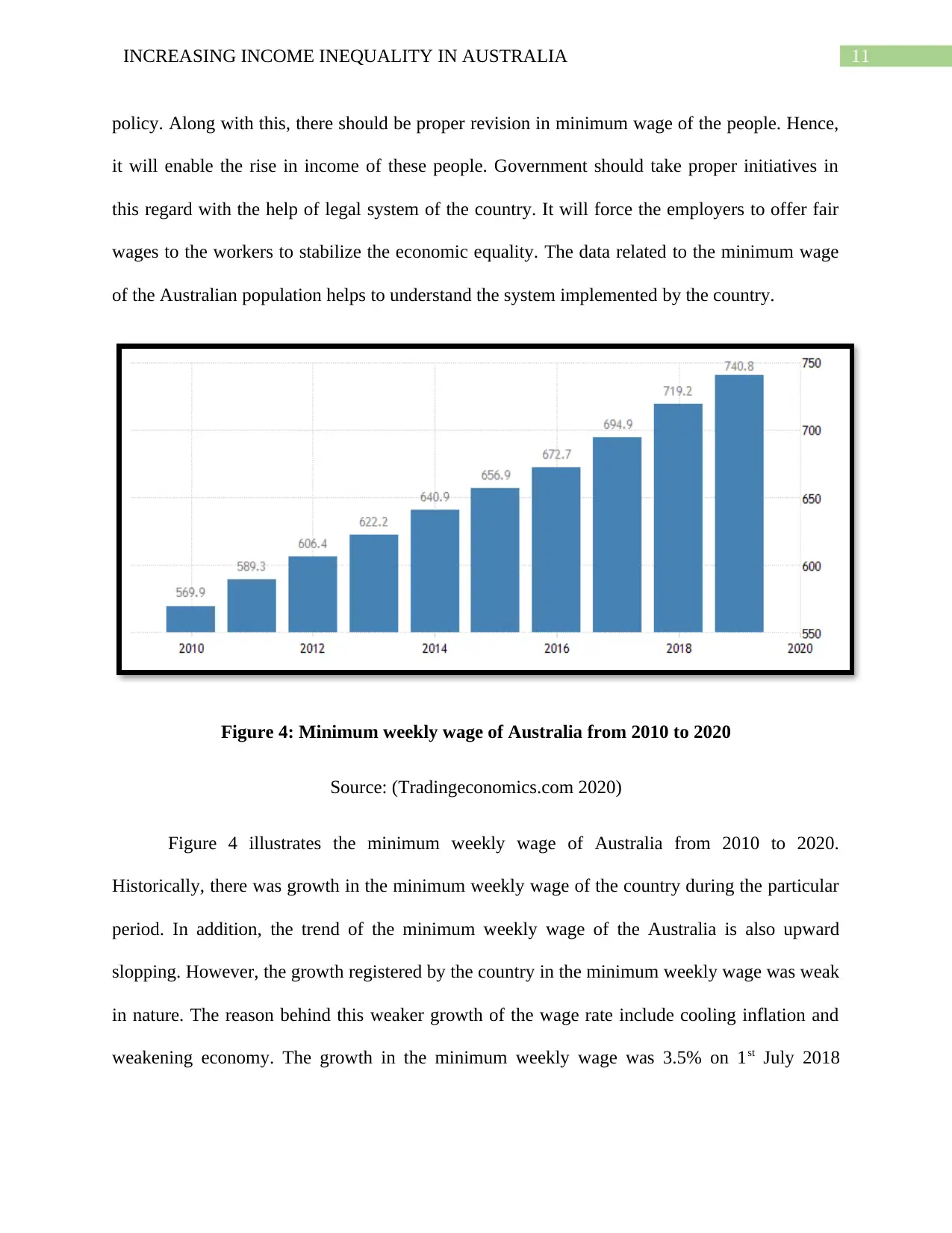
11INCREASING INCOME INEQUALITY IN AUSTRALIA
policy. Along with this, there should be proper revision in minimum wage of the people. Hence,
it will enable the rise in income of these people. Government should take proper initiatives in
this regard with the help of legal system of the country. It will force the employers to offer fair
wages to the workers to stabilize the economic equality. The data related to the minimum wage
of the Australian population helps to understand the system implemented by the country.
Figure 4: Minimum weekly wage of Australia from 2010 to 2020
Source: (Tradingeconomics.com 2020)
Figure 4 illustrates the minimum weekly wage of Australia from 2010 to 2020.
Historically, there was growth in the minimum weekly wage of the country during the particular
period. In addition, the trend of the minimum weekly wage of the Australia is also upward
slopping. However, the growth registered by the country in the minimum weekly wage was weak
in nature. The reason behind this weaker growth of the wage rate include cooling inflation and
weakening economy. The growth in the minimum weekly wage was 3.5% on 1st July 2018
policy. Along with this, there should be proper revision in minimum wage of the people. Hence,
it will enable the rise in income of these people. Government should take proper initiatives in
this regard with the help of legal system of the country. It will force the employers to offer fair
wages to the workers to stabilize the economic equality. The data related to the minimum wage
of the Australian population helps to understand the system implemented by the country.
Figure 4: Minimum weekly wage of Australia from 2010 to 2020
Source: (Tradingeconomics.com 2020)
Figure 4 illustrates the minimum weekly wage of Australia from 2010 to 2020.
Historically, there was growth in the minimum weekly wage of the country during the particular
period. In addition, the trend of the minimum weekly wage of the Australia is also upward
slopping. However, the growth registered by the country in the minimum weekly wage was weak
in nature. The reason behind this weaker growth of the wage rate include cooling inflation and
weakening economy. The growth in the minimum weekly wage was 3.5% on 1st July 2018
⊘ This is a preview!⊘
Do you want full access?
Subscribe today to unlock all pages.

Trusted by 1+ million students worldwide
1 out of 19
Related Documents
Your All-in-One AI-Powered Toolkit for Academic Success.
+13062052269
info@desklib.com
Available 24*7 on WhatsApp / Email
![[object Object]](/_next/static/media/star-bottom.7253800d.svg)
Unlock your academic potential
Copyright © 2020–2025 A2Z Services. All Rights Reserved. Developed and managed by ZUCOL.





